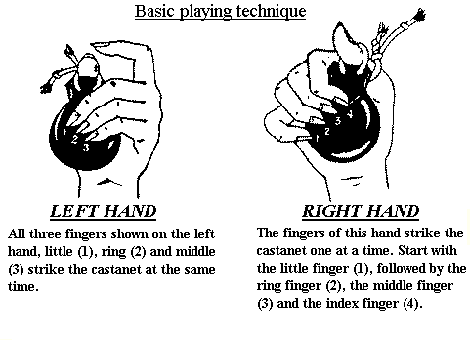Castanets are pair of shell shaped wooden plates that are held together in one hand, and provide rhythmic accompaniment during a dance. The name is probably derived fron the word CASTANA (chestnut) due their chestnut shell shape. Valencians call them POSTIZOS; Aragoneses call them PULGARETES; Castillians call them CASTANUELAS . Andalucians call them PALILLOS. Palillos means little sticks. This name lends itself to the theory that castanets evolved from the ancient practice of holding two sticks in one hand and rhythmically striking them together during a dance. The origin is variously attributed to the aincient Greeks, Egyptians and Phonecians.
Contrary to general belief, castanets are neither indigenous nor unique to Spain. The exact origin of castanets is not known. We do know that the Moors have used chinchines for many centuries. One of the stylized designs of ancient China is a pair of castanets, called "pans". Today in India, dancers use a long narrow pair of wooden clappers called "bhajinnas", or "chittakas". From at least the sixth century BC, Greek icons and friezes show dancing women wielding krotala, long wooden clacks. The Romans called them crotala. Instruments similar to these are seen in the hands of dancers in ancient Egyptian paintings. The Egyptian version is said to have evolved from a throwing stick similar to a boomerang. (from "Dance Trivia" website)
There are two major styles for playing Spanish castanets, classic and folkloric. Castanets held in the right hand (hembra, female) are of higher pitch than those held in the left (macho, male).
In the classic style, castanets are tied to the thumbs, thereby allowing the fingers of the right hand to strum successively on the outer shell to produce carretillas (rolls and trills) as the left-hand pair marks the rhythm with golpes (single strokes). Manuscripts of the Baroque era (c.1600-1750) give specific directions and diagrams for rolling both castanets simultaneously.
In folkloric dances, castanets are usually larger, have a lower pitch, and are strung on one or more fingers. With a flicking action of the
wrist the two halves are thrown against the palm, producing a loud staccato sound that is quite different from the sound produced when
castanets are played in the classical manner. (Oxford international encyclopedia of dance)
The use of the flamenco castanets is common with the festive styles of flamenco dance such as Sevillanas, Garrotín and Fandangos. I am not
aware of any 'rules' to dicatate which dance forms castanets may or may not be used with. Even if such traditional rules existed, it would
only be a matter of time before it became popular to break them. Generally speaking, castanets don't seem all that appropriate in the more
serious forms such as Soleares, Siguiriyas and Tientos. Orchestral castanets are attached to handles and shaken or fastened to a block of
wood and played with the fingers or drumsticks.
|
Orchestral castanets or ‘clappers’, mounted on a handle, were employed by silent-film effects musicians to imitate the sound of a galloping horse, hence the phrase ‘to run like the clappers’. Research Machines plc 2004. |

Drawing courtesy of Flamenco World - used here with permission


